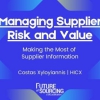Cloud Compliance and 4 Ways to Improve It
Cloud compliance accounts for a company adhering to previously established cloud usage regulations and standards that are dictated by both federal laws and industry guidelines. Let’s say your business operates within the FinTech industry. This means that you must adhere to the Fintech Law (comprising 100+ laws and multiple regulators, tribunals, etc.) in terms of how you store and handle customer data. The same goes for the healthcare industry for storing and handling patient data, and so on.
Businesses that do not comply with all the necessary laws, regulations and standards are exposed to great risks and face adverse consequences. Typically, these consequences come in the form of fines, fees, or complicated and reputation-damaging legal issues that could set you back significantly, in terms of both company progress and resources.
This is why cloud compliance is one of the most critical aspects of running an organization. It involves taking appropriate measures so your business is compliant with these standards and laws, making sure you are always on the safe side.
Improving your cloud compliance strategy is actually not a complex task. Here are some of the cloud compliance best practice steps you can take.
Understand the SLAs (Service Level Agreements)
Although service level agreements have been the standard across numerous industries for quite a while now, there are still companies that do not take them seriously and don’t prioritize them. For example, cloud service providers often send potential customers standard, boilerplate SLAs that are then merely skimmed and signed, without the customer understanding the terms in their entirety.
These insufficient levels of understanding of how cloud providers store and handle a company’s data can be quite risky, especially in the long run. This is why it is crucial that a business works with a cloud provider so both sides have a clear overview of the way data and sensitive information would be managed.
The SLA should provide the following information and guidelines:
- How the data is accessed and by whom
- How the environment is segmented
- Geographic location
Know Data Management Best Practices that Best Work for You
Having a solid security and data privacy strategy that will help you tackle cloud compliance is impossible if you don’t have a proper understanding of data and how it should be managed. This is why a business must have a firm grasp of the following:
- Data classification (identifying all the types of data you manage)
- The ways this data is gathered and collected
- How and where this data is stored
- The time frame from storing certain pieces of data
- If and how your communication channels are affecting your data security
One data management aspect that companies overlook most often in terms of data privacy and security is handling the information that goes through numerous communication channels, mainly email platforms. Email platforms are the most widely used channels among companies and their customers, but the measures for preventing risky and sub-optimal approaches to managing email-based data are rarely taken seriously.
In order to prevent losing pertinent data, or to minimize potential legal issues due to missing email-based information, it is highly recommended that businesses utilize email archiving solutions that can automate these processes for them.
It is also suggested that a company has a strong email retention policy in place. This can help optimize storage and data retention costs, all while automating regulatory compliance tasks with professional expertise.
Once an organization outsources these time-consuming technicalities and chores, it enables them to invest more time and energy into productive workflows that actually drive and bring revenue.
Have a Firm Grasp of the Cloud Model Your Company is Using
In order to make sure that your cloud compliance strategy is as effective as possible, your team needs to have a strong understanding of how the cloud model your company is implementing actually works. If you don’t understand all the components of the public, private or hybrid cloud model that underpins your business infrastructure, it is almost impossible to tackle cloud compliance in terms of data protection.
Discerning security or compliance issues for different cloud models can vary significantly. The tricky part is that the integration of cloud services into your company’s practices and processes doesn’t necessarily mean that your business now automatically adheres to all compliance obligations. This is why companies need to have sufficient knowledge of how different cloud models are configured in terms of compliance responsibilities and best practices.
Take Care of Employee Data Access and Authentication
One of the main tasks when it comes to remaining fully compliant is to properly regulate data access levels among your employees. The common best practice advice for this task is the implementation of multifactor authentication so your most sensitive data stays protected all the time. Multifactor authentication accounts for a practice of requiring multiple forms of identification before a user is able to access and handle certain pieces of information.
For example, this may involve internal systems within your business that require employees to input both a password and specialized access code that is typically generated when the correct password is being entered. The code stops being valid after a certain period of time. These codes are sent to employees’ emails so only the right user can access the data in question.
There are also other forms of multifactor authentication like physical identification badges. An employee could be required to show an identification badge prior to entering a storage room that stores hard drives. The user or employee may be required to insert the correct password to access sensitive information located on the drive.
Certain companies that deal with extremely sensitive data or company secrets tackle cloud access management and centralized platform configuration so only certain individuals are granted access to sensitive information.
Closing Statement
Data classification, proper security layers, understanding how cloud models work and what their SLAs imply are just some of the basic ways to improve your cloud compliance strategy. This issue comes with great responsibility and involves having a firm grasp of the most common threats that a business can face in terms of data loss.
It is strongly suggested that you consistently and regularly educate both yourself and your employees about existing as well as emerging security trends that permeate the industry and niche your business operates in.









